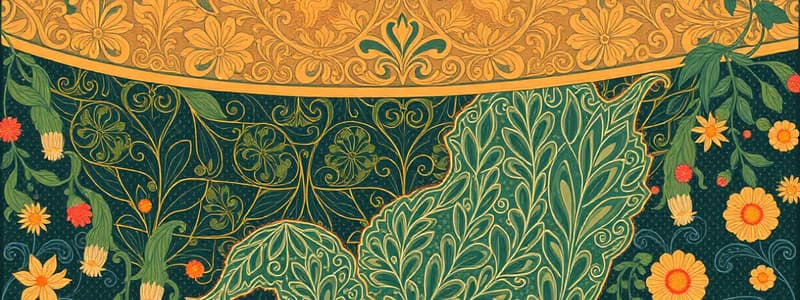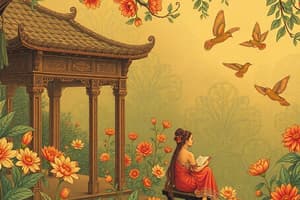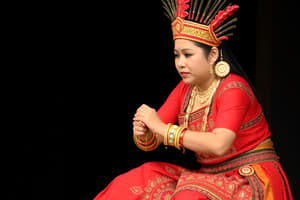Podcast
Questions and Answers
Match the following traditional Filipino textiles with their corresponding cultural groups:
Match the following traditional Filipino textiles with their corresponding cultural groups:
Pis syabit = Tausug Malong = Maranao Tepo Mat = Sama Bubo = Ilocano
Match the following traditional Filipino crafts with their primary materials:
Match the following traditional Filipino crafts with their primary materials:
Ovaloid Baskets = Nito and bamboo Bubo = Sturdy bamboo strips Pis syabit = Silk or cotton Malong = Cotton or silk
Match the following traditional Filipino pottery types with their primary uses:
Match the following traditional Filipino pottery types with their primary uses:
Palayok = Cooking Banga = Storing liquids Tapayan = Storing liquids Burnay = Various purposes
Match the following traditional Filipino art forms with their corresponding regions:
Match the following traditional Filipino art forms with their corresponding regions:
Match the following traditional Filipino art forms with their primary themes:
Match the following traditional Filipino art forms with their primary themes:
Match the following traditional Filipino art forms with their historical periods:
Match the following traditional Filipino art forms with their historical periods:
Match the following traditional Filipino adornments with their corresponding cultural groups:
Match the following traditional Filipino adornments with their corresponding cultural groups:
Match the following traditional Filipino art forms with their primary functions:
Match the following traditional Filipino art forms with their primary functions:
Match the following pre-colonial Philippine rituals with their respective regions:
Match the following pre-colonial Philippine rituals with their respective regions:
Match the following pre-colonial Philippine musical instruments with their descriptions:
Match the following pre-colonial Philippine musical instruments with their descriptions:
Match the following pre-colonial Philippine dance forms with their mimetic inspirations:
Match the following pre-colonial Philippine dance forms with their mimetic inspirations:
Match the following pre-colonial Philippine carvings with their purposes:
Match the following pre-colonial Philippine carvings with their purposes:
Match the following pre-colonial Philippine rituals with their purposes:
Match the following pre-colonial Philippine rituals with their purposes:
Match the following pre-colonial Philippine terms with their meanings in the context of art history:
Match the following pre-colonial Philippine terms with their meanings in the context of art history:
Match the following Filipino cultural elements with their corresponding regions or groups:
Match the following Filipino cultural elements with their corresponding regions or groups:
Match the following Islamic elements with their corresponding architectural features:
Match the following Islamic elements with their corresponding architectural features:
Match the following Islamic elements with their corresponding cultural practices:
Match the following Islamic elements with their corresponding cultural practices:
Match the following ethnic groups with their corresponding regions or cultural practices:
Match the following ethnic groups with their corresponding regions or cultural practices:
Match the following terms with their corresponding meanings:
Match the following terms with their corresponding meanings:
Match the following artistic elements with their corresponding functions or significance:
Match the following artistic elements with their corresponding functions or significance:
Match the following elements with their corresponding cultural traditions:
Match the following elements with their corresponding cultural traditions:
Match the following elements with their corresponding interpretations:
Match the following elements with their corresponding interpretations:
Flashcards
Pre-conquest Art
Pre-conquest Art
Art before colonization, rooted in indigenous culture and rituals.
Mayvanuvanua
Mayvanuvanua
A ritual from Batanes that marks the fishing season of dibang (flying fish).
Cañao/Kanyaw
Cañao/Kanyaw
A ritual in the Cordillera involving animal sacrifice and divination by a shaman.
Kashawing
Kashawing
Signup and view all the flashcards
Kudyapi
Kudyapi
Signup and view all the flashcards
Pangalay
Pangalay
Signup and view all the flashcards
Bulul
Bulul
Signup and view all the flashcards
Sarimanok
Sarimanok
Signup and view all the flashcards
Pako Rabong
Pako Rabong
Signup and view all the flashcards
Manunggul Jar
Manunggul Jar
Signup and view all the flashcards
Palayok
Palayok
Signup and view all the flashcards
Pis Syabit
Pis Syabit
Signup and view all the flashcards
Malong
Malong
Signup and view all the flashcards
Tattoos in the Visayas
Tattoos in the Visayas
Signup and view all the flashcards
Bontoc Warrior's Necklace
Bontoc Warrior's Necklace
Signup and view all the flashcards
Ovoid Baskets
Ovoid Baskets
Signup and view all the flashcards
Bawisak Earrings
Bawisak Earrings
Signup and view all the flashcards
Brass Kendi and Gadur
Brass Kendi and Gadur
Signup and view all the flashcards
Sultanate of Sulu
Sultanate of Sulu
Signup and view all the flashcards
Tawhid
Tawhid
Signup and view all the flashcards
Mihrab
Mihrab
Signup and view all the flashcards
Panolong
Panolong
Signup and view all the flashcards
Bulbous Dome
Bulbous Dome
Signup and view all the flashcards
Burraq
Burraq
Signup and view all the flashcards
Signup and view all the flashcards
Study Notes
Pre-Conquest Philippine Art
- Pre-conquest Philippine art is described in three ways:
- Historically, it is "pre-conquest."
- Stylistically, it is "Indigenous."
- Culturally, it is "Pre-colonial."
- Art forms were integrated within rituals.
Pre-Colonial Art Forms
- Mayvanuvanua (Batanes): A ritual opening the fishing season for flying fish (dibang).
- Cañao or Kanyaw (Cordillera Administrative Region): A ritual officiated by a shaman or mumbaki, involving animal sacrifice and divination through entrails.
- Kashawing (Lake Lanao of Mindanao): A ritual ensuring abundance during rice planting and harvesting.
- Tagbanwa (Palawan): Shamans enter a trance during rituals, believed to be possessed by goddesses, through chanting and dancing.
Ethnic Musical Instruments
- Kudyapi: A two-stringed guitar.
- Kulintang: An array of bossed gongs.
- Gansa: A flat gong.
- Agong: A large bossed gong.
Native Dance Forms
- Pangalay (Sulu): A mimetic dance of seabirds.
- Kinabua (Mandaya): A dance mimicking the swooping movements of an eagle.
- Banog-banog (Higaonon & B'laan): A courtship dance portraying birds in flight.
- Man manok (Bago Tribe): A dance where three roosters compete for a hen (Lady Lien).
- Talip (Ifugaos): A courtship dance mimicking wild fowls' movements.
- Inamong (Matigsalugs & Kadaliwas): A comedic dance representing monkey movements.
- Tinikling (Tagalog): A dance mimicking a crane balancing on stilt-like legs or fleeing bamboo traps.
Carving
- Bulul (Cordillera): A granary god in rituals, appearing as anthromorphic figures in containers, bowls, and spoons.
- Hagabi (Ifugao): A wooden bench that signifies the socio-economic status of its owner.
Stylized Designs
- Sarimanok: A stylized design of a bird holding a fish in its beak, often standing on a fish-shaped base.
- Naga: A serpent or dragon with an elaborate S-curve, numerous curvilinear motifs, depicting scales.
- Pako rabong: A stylized fern-like design with a wide base tapering upwards.
Islamic Colonial Art (13th Century to Present)
-
Islam was culturally dominant in Southern Philippines.
-
Islam gained significance in Sulu by the 13th century.
- Sayyid Abubakar married Princess Piramisuli, daughter of Rajah Baguinda, establishing the Sultanate of Sulu.
-
Elements influencing Islamic art include:
- Quran
- Madrasa
- Tausug, Maranao, Maguindanao, Yakan, Samal, Badjao
- Areas of Palawan
-
Art is influenced by the notion of Tawhid, emphasizing impermanence of nature and divine being.
-
Islamic art characteristics include:
- Interior of mosques are covered with elaborate patterning in the form of reliefs.
- Abstract forms and patterns
- Parts of the Mosque like mihrab/niche and Qibla wall oriented toward west.
- Bulbous Domes (octagonal base-spirits, 4-sided-earth/material world).
- Courtyards (Ka'bah-black shrine believed to be built by Prophet Muhammad himself.)
- Water supply area for ablution or cleansing
- Gardens within or outside mosques or homes.
- Upward orientation of Islamic forms.
-
Architecture includes:
- Panolong (elaborate carved protusion resembling a wing attached to a torogan.)
- Luhul (canopy inspired by tree of life)
-
Figures include:
- Burraq (horse with a woman's head)
Pottery
- Manunggul Jar (Palawan): Late Neolithic Period (890-710). Two human forms atop the lid. The human figure (anthropomorphic) is more pronounced on jars of the Metal Age (5 BC-225 AD), especially on the lid (head) and base/body.
- Pottery later became associated with cooking and storing liquids (palayok, banga and tapayan. Burnay pottery is a lively tradition in Vigan Ilocos.
Weaving
-
According to Respicio, Philippine ethnolinguistic groups have a rich weaving tradition stretching back in history.
-
Textiles not just functional but also impart knowledge about belief systems, reverence for spirits/nature and society's structure.
-
Examples of woven items:
- Pis syabit (headpiece of Tausug of Sulu).
- Malong (tapestry panels called langkit woven by the Maranao of Lanao Del Sur).
- Tepo Mat (double-layered mats of Sama of Tawi-Tawi made of pandan leaves)
Other Art Forms
- Ovaloid Baskets and Bubos: Baskets and fish traps of nito and bamboo used in harvest carrying and traps in Ilocos region respectively.
- Tattoos: Visayas "Islands of Painted Ones" shared by Southeast Asia and New Zealand, Kalinga, Kankanay, Ibaloy etc are practitioners.
- Jewelry: T'boli are known for brass chains, bells, and colourful beads.
- Lotoans: Betel nut boxes of varied shapes.
- Brass Kendi and Gadur: Used in ceremonies, cherished as status/heirloom pieces.
Studying That Suits You
Use AI to generate personalized quizzes and flashcards to suit your learning preferences.




